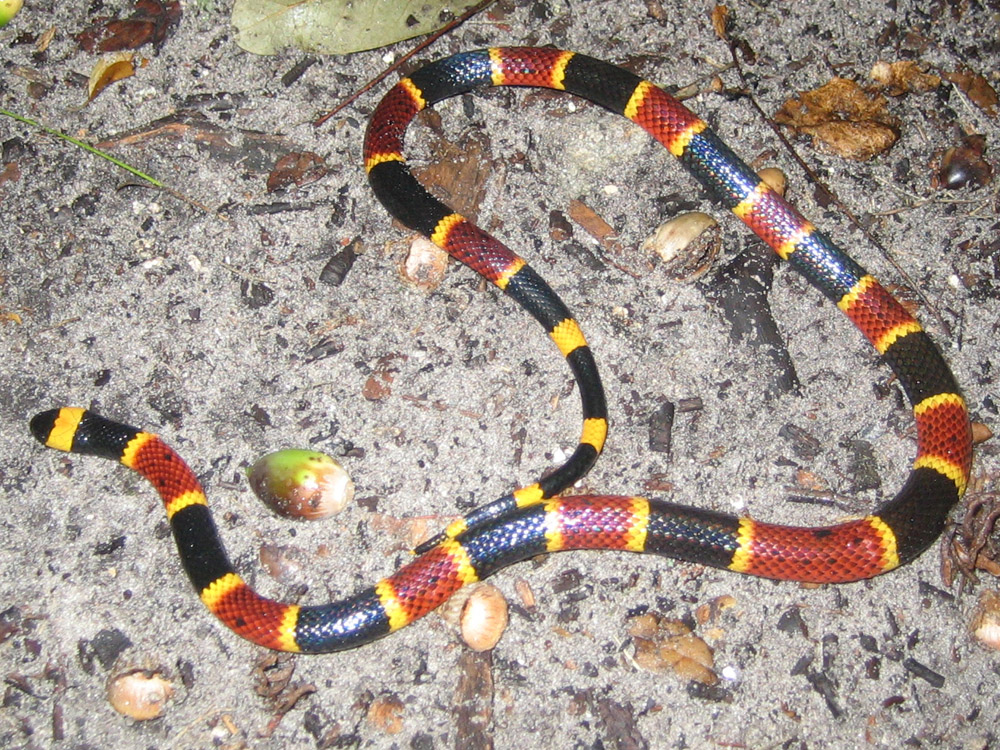|

 |
The Eastern Coral Snake has a powerful neurotoxin, but it's not aggressive. |
 |
DESCRIPTION: As you can see,
this snake is small and thin. But don't let it bite you!
If you need snake removal in your town, click for the National Directory of
Snake Removal Companies that I've carefully compiled in every USA city.
Eastern Coral snakes are usually different from one another in terms of their behavior, but the majority of them are quite elusive. Coral snakes have a small pair of fangs that are able to deliver their venom to their prey and victims. These fangs are hollow and enlarged. While the venom is poisonous and contains neurotoxins that are able to paralyze their victim and stop the respiratory system from properly working, the Coral snake must usually administer 75 to 100 mg of venom for the bite to be fatal. Coral snakes have a body that contains black, red and yellow rings. These rings continue all around the snake’s belly. The tail of the Cobra snake is black and yellow and does not contain any red markings. This reptile contains smooth scales.
Coral snakes are usually not aggressive and rarely bite humans. In fact, their bites account for less than one percent of all snake bites that occur throughout the year. When a Coral snake does bite their victim they will usually hold onto the victim. This differs from other snakes that will generally bite their victim and immediately let go.
Instead of biting, when a Coral snake senses danger they tend to hide their head into their body for protection. During the day, these elusive snakes will usually hide in holes that were created by other animals. They also enjoy living in tree stumps, logs, and in rotting leaves. Coral snakes will usually feed on smaller reptiles such as frogs, fish and even other Coral snakes. Coral snakes are usually born at a length of seven inches and are fully venomous. Adult snakes will usually reach about two feet. While the average lifespan of a Coral snake that lives in the wild is unknown, they are able to live up to seven years while they are in captivity.
Running a wildlife removal business in the state of Florida gives me the chance to see all kinds of interesting snakes! Florida has about 45 species of snake, and I've seen 29 of them so far. I've always got my eye out for new species, and
I love spotting rare snakes in Florida. I also have a thing for venomous snakes - they're not too common in FL, so I always enjoy the chance to see a poisonous serpent. I really like snakes, and I've never hurt or killed one. They're an
important part of the ecosystem, and often persecuted. Still, if you don't want snakes in your house or on your property, and judging from the number of phone calls I receive regarding snake problems, you don't, then give me or a local snake
expert in your area a call, and we can remove the snakes from your property for you. I use many snake control methods - from snake traps, to snake repellents, to habitat modification, but most of all, good old-fashioned capture and removal.
If you want to learn more, please read my How To Get Rid of Snakes page.
AAAnimal Control is a privately owned wildlife removal and pest control business, located in Orlando Florida. I deal strictly with wild animals including snakes inside houses. I am not an extermination company, but a critter removal
and control specialist. The above photos are some of the many that I've taken in the field over my years of work. Please email me if
you have any questions about the above photographs, or any questions about
wildlife problems or Florida snake removal issues.
You can safely catch snakes with a special trap, which you can order by clicking this banner:

|
| |
|